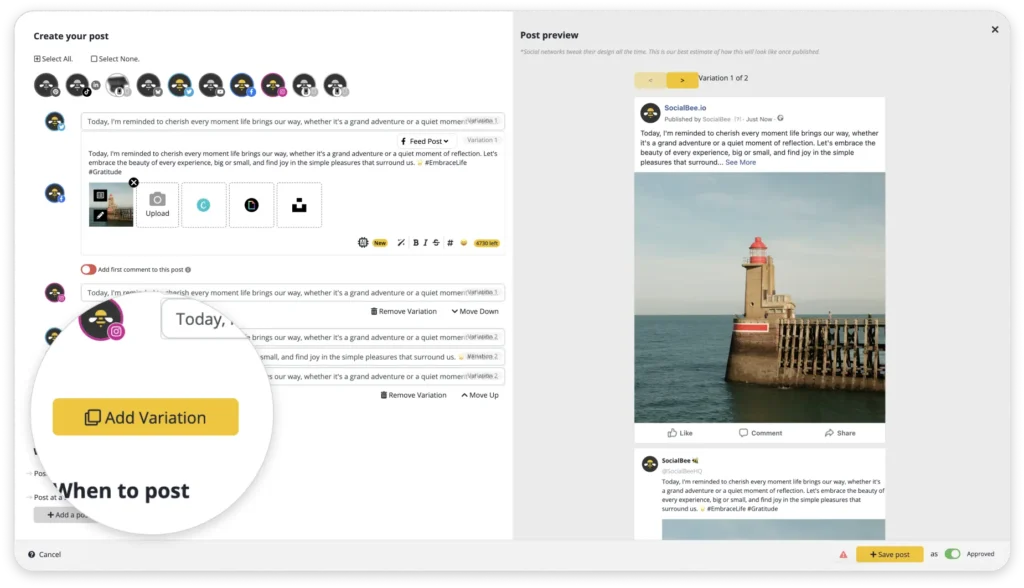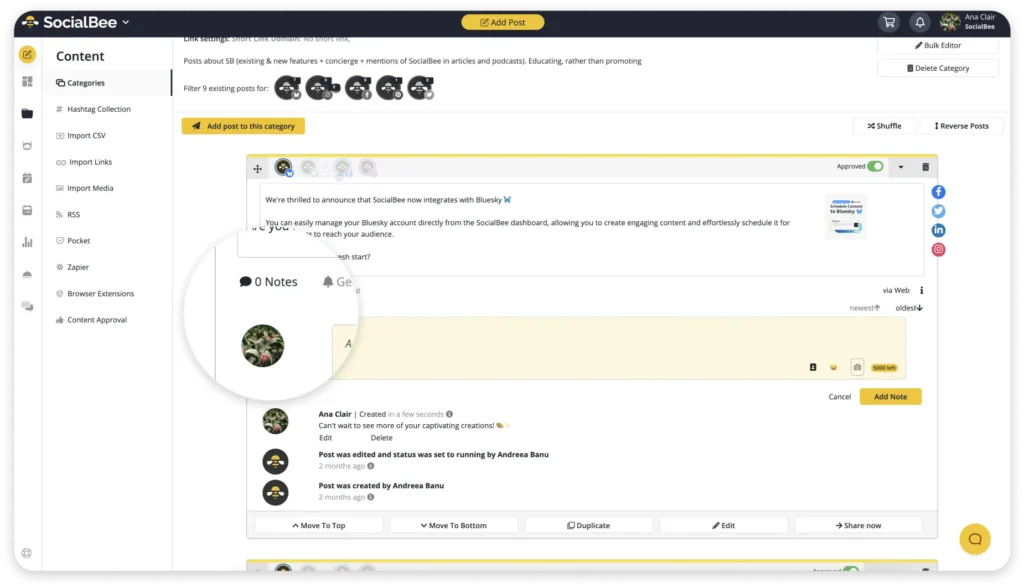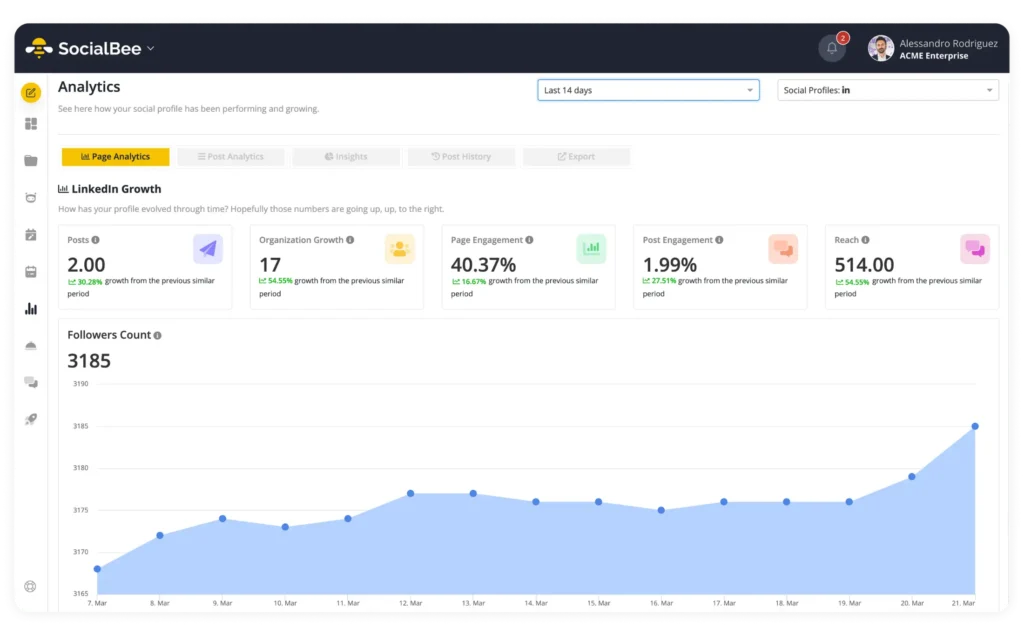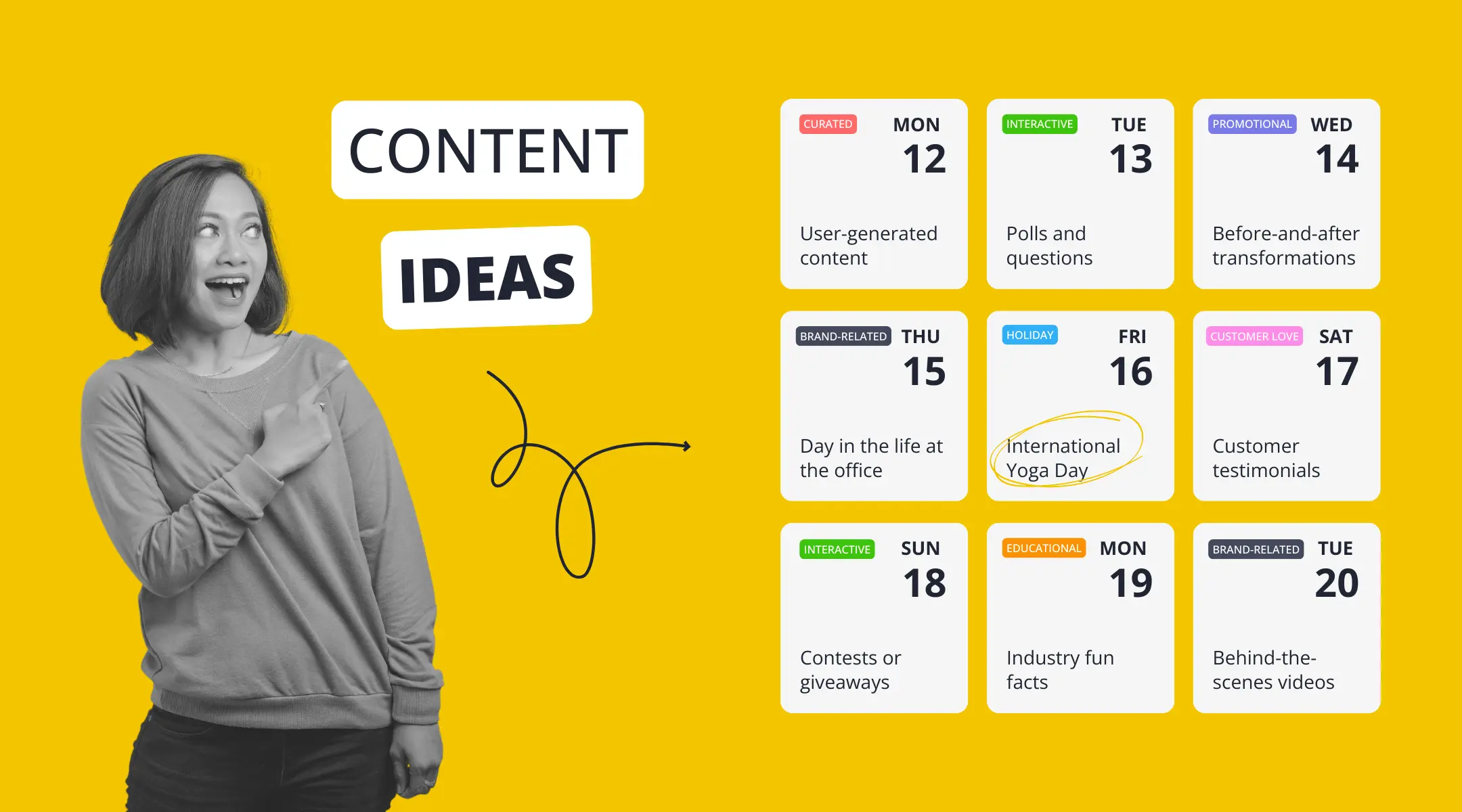
Content Writer at SocialBee
Did you know that to stand out in the digital space, you need more than occasional posts and creative ideas? What you require is a well-organized and efficient social media content creation workflow.
In this article, we will dissect the elements of crafting an efficient social media content creation workflow, covering all the essentials you need to elevate your social media game.
Whether you’re a seasoned marketer or a business owner new to the digital world, we’ve got you covered. Let’s dive in and transform your social media strategy into a seamless and successful endeavor!
Diversify your social content strategy with over 500 engaging post ideas.
Short Summary
- A content creation workflow is a clear blueprint that directs the creation, optimization, and distribution of content.
- Various types of workflows can be adopted, each suited to different team structures and project needs. Two of the most common are task-based workflows and status-based workflows.
- To develop an effective content creation workflow, you must define your content creation objectives, align them with your business goals, and tailor your content to meet the needs and interests of your target audience.
- Then, select the most suitable content types and social media platforms based on your audience and goals. Customize content for each platform’s requirements.
- Proceed to define the roles and responsibilities of your content creation team, ensuring everyone is on the same page and understands how they contribute to the overall strategy.
- Break down the content creation process into tasks, estimate time requirements, and use project management tools to create timelines with due dates for efficient progress tracking.
- Develop and document your content creation process, including idea generation, production, review, publishing, promotion, and optimization.
- Utilize content workflow software like SocialBee to streamline your content creation workflow, from generating content ideas to scheduling posts and analyzing performance.
- Continuously analyze the effectiveness of your content marketing strategy through data collection, monitoring key metrics, competitor analysis, content performance evaluation, and audience insights. Use these insights to make data-driven improvements.
Table of Contents
- What Is a Content Workflow?
- Why Do You Need a Content Workflow?
- Why Is Creating Content without a Content Workflow Bad?
- Types of Content Workflows
- How to Choose the Right Content Creation Workflow for You
- How to Create a Good Content Creation Workflow
- 1. Determine Your Content Creation Objectives
- 2. Choose Content Types and Distribution Channels
- 3. Assign Roles and Responsibilities
- 4. Set Realistic Timelines for Each Task
- 5. Develop and Document Your Content Creation Process
- 6. Automate Your Content Creation Workflow
- 7. Analyze the Effectiveness of Your Content Marketing Strategy Frequently
- Frequently Asked Questions
- Create Seamless Content Creation Workflows with SocialBee!
What Is a Content Workflow?
A content creation workflow is a clear blueprint that directs the creation, optimization, and distribution of content.
Its goal is to outline the steps and responsibilities involved in content creation in an organized manner. This helps marketers manage their tasks from the initial idea to the ultimate publication, making it easier to produce high-quality, impactful content.
Why Do You Need a Content Workflow?
If your content creation process needs structure, efficiency, and strategic focus, developing a workflow is mandatory.
Here are the benefits of having a well-defined content workflow:
- Efficiency and time management: When tasks are clearly defined and assigned, there is no confusion and overlap, which results in a more efficient allocation of time and resources.
- Strategic alignment: In an effective content marketing workflow, each piece of content is created with a clear purpose, whether it’s driving engagement, generating leads, or building brand awareness.
- Improved collaboration and communication: When every team member understands their responsibilities and deadlines, collaboration and communication can happen at optimal levels.
- Enhanced creativity: By reducing the time and energy spent on process-related decisions, team members can focus more on the creative aspects of content creation.
- Effective measurement and optimization: Reviewing metrics and KPIs enables the optimization of future content to meet your content marketing goals.
- Documented process for training and onboarding: A documented workflow provides new employees with a clear understanding of how things are done, ensuring consistency even when changes occur.
- Adaptability and responsiveness: Having a structured process allows you to be adaptable and responsive to changing market trends, audience preferences, and business goals.
Why Is Creating Content without a Content Workflow Bad?
Not having a content workflow can have the following consequences:
- Inconsistency in content quality and brand voice: Without a workflow, there’s a higher risk of producing content that varies in quality and deviates from the established brand voice. This may confuse your audience and weaken your brand identity.
- Difficulty in scaling content production: Scaling up content production can be inefficient without the right systems in place, destroying your ability to meet increased demand.
- Ineffective use of content: Without a workflow, there’s a tendency to produce content for the sake of it, rather than creating strategically thought-out pieces.
- Higher risk of burnout: The disorganization and inefficiencies of not having a system can place stress on your team, leading to burnout and reduced job satisfaction.
- Compromised legal and ethical standards: When there’s no structured approval process, there’s a higher risk of publishing content that hasn’t been vetted for legal and ethical standards. This can lead to legal issues or damage to your brand’s reputation.
Types of Content Workflows
Various types of workflows can be adopted, each suited to different team structures and project needs. Two of the most common are task-based workflows and status-based workflows.
A. What Is a Task-Based Workflow?
A task-based workflow is a linear and detailed approach where each step in the content creation process is defined as a specific task. This workflow is highly structured and is particularly effective in environments where tasks are specialized and need to be completed in a certain order.
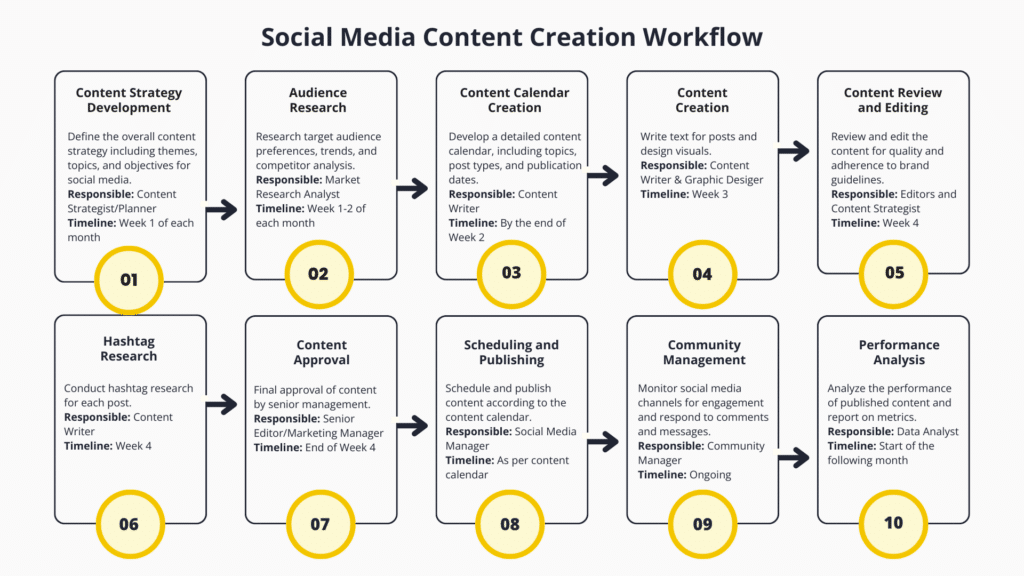
Task-Based Workflow Characteristics:
- Sequential tasks: Each task is a distinct step in the creation process, such as researching, writing, editing, and publishing.
- Specialization: In this workflow, tasks are assigned to team members based on their specific skills and expertise.
- Clear responsibilities: This format defines who is responsible for each task, reducing overlap and ensuring accountability.
- Timeline-focused: Every task is associated with a deadline, making it easier to track progress and ensure the timely completion of content.
The Task-Based Workflow Is Best Suited For:
- Teams with specialized roles
- Projects that need a high degree of accuracy and quality control
- Environments where the order of operations is crucial to the outcome
B. What Is a Status-Based Workflow?
A status-based workflow is more dynamic and focuses on the stage or status of the content within the creation process. This workflow is ideal for teams that require flexibility.
Tools like Trello are well-suited for status-based workflows like social media content creation, offering visual organization, flexibility, collaborative features, and progress tracking.
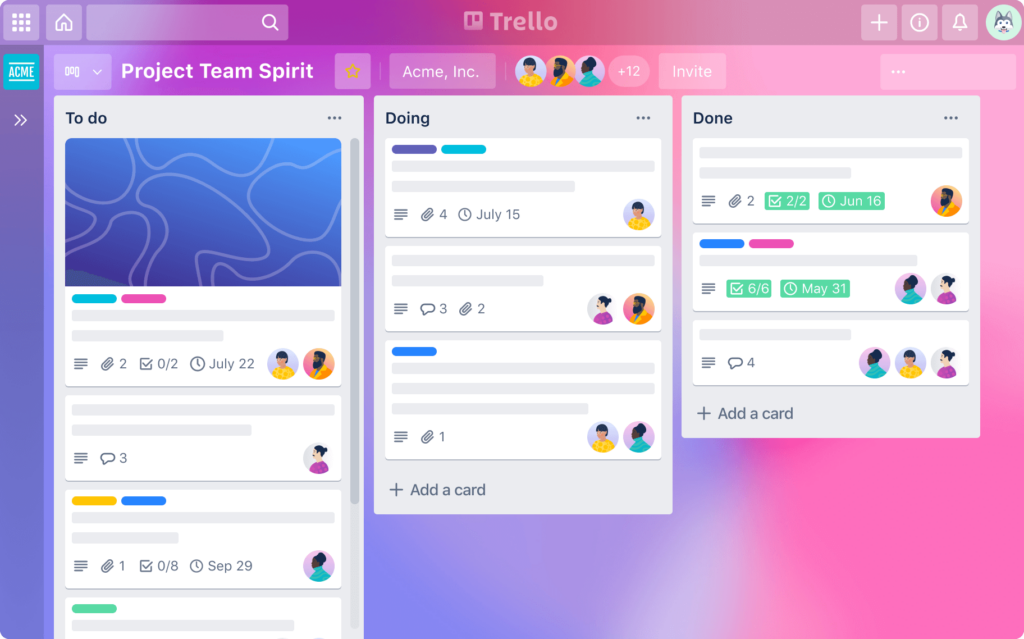
Status-Based Workflow Characteristics:
- Flexible stages: Content moves through various stages, such as ‘In Progress,’ ‘Review,’ or ‘Published.’
- Collaborative approach: This workflow encourages collaboration, as team members can work on various aspects of the content simultaneously, depending on its status.
- Adaptability: It’s easier to make changes in a status-based workflow, as content can move back and forth between stages for additional improvements.
- Progress tracking: The focus is on the status of the content, making it easy to track its progress through the workflow.
The Status-Based Workflow Is Best Suited For:
- Teams that rely on collaboration and flexibility
- Fast-paced environments where content needs may change rapidly
- Projects that benefit from continuous improvement
How to Choose the Right Content Creation Workflow for You
Choosing a suitable content creation workflow is critical for digital marketing success.
Here’s how to choose the right content creation workflow:
- Assess your team and goals: Start by understanding your team’s strengths and the nature of your content. If you have specialized team members (e.g., blog post writers), consider a task-based workflow. If your team is collaborative and juggles multiple tasks (e.g., a marketing team), a status-based workflow may work better.
- Evaluate content complexity: For complex content like technical guides or research reports, a task-based workflow ensures that each step is properly executed. However, if your content evolves through multiple revisions and iterations, a status-based workflow accommodates these changes efficiently.
- Consider scalability and tools: Acknowledge how your workflow will scale as your business grows. Task-based workflows may require more resources and structure, whereas status-based workflows offer adaptability and can easily accommodate increased content demands.
- Trial and feedback: Before committing fully, run pilot programs with both workflow types on smaller projects. Gather feedback from your team for each approach, so you can make a decision that suits your team’s needs and content goals.
How to Create a Good Content Creation Workflow
Designing a content workflow is not a one-size-fits-all decision. It involves a careful analysis of your team dynamics, content requirements, production processes, content creation tools, and future scalability.
Here is how to create a good content creation workflow:
- Determine your content creation objectives
- Choose content types and distribution channels
- Assign roles and responsibilities
- Set realistic timelines for each task
- Develop and document your content creation process
- Automate your content creation workflow
- Analyze the effectiveness of your content marketing strategy frequently
1. Determine Your Content Creation Objectives
Begin by thoroughly understanding your overall business goals. Do you want to increase brand awareness, drive sales, or skyrocket customer engagement? Your content should directly support these objectives.
Afterward, identify and understand your target audience. What are their preferences, interests, pain points, and online behaviors? Tailor your objectives to address these requirements. This might include educating them, solving their problems, or providing entertainment.
PRO TIP #1: Make your objectives specific, measurable, achievable, relevant, and time-bound (SMART). For instance: “Increase Instagram engagement rate by 20% over the next quarter.”
PRO TIP #2: Establish the KPIs you will use to measure the success of your content against your objectives. These might include engagement rates, follower growth, website traffic from social media, or conversion rates.
2. Choose Content Types and Distribution Channels
Depending on your audience and goals, select the most appropriate content types. Common options include:
- Text posts: Simple text updates, captions, and tweets
- Images: High-quality visuals, graphics, infographics, and memes
- Videos: Short videos, live streams, tutorials, and animations
- User-generated content: Prompt customers to create content related to your brand
- Written pieces: Publishing blog posts or in-depth articles
- Podcasts: Audio content for storytelling or education
- Interactive content: Quizzes, polls, contests, and surveys
Then, decide which social media platforms are most suitable for your content and audience. Popular options include:
- Facebook: Great for engaging live videos, authentic user-generated content, interactive posts like polls and quizzes, and informative or educational material
- Instagram: Visual-heavy with photos and short videos
- X (Twitter): Ideal for quick updates and news
- LinkedIn: B2B-focused for professional content
- YouTube: Suitable for long-form and short-form videos, live events, and Shorts
- TikTok: Ideal for short video content targeting younger demographics
- Pinterest: Visual platform for DIY and lifestyle content
PRO TIP: Customize your content for each platform’s specific requirements and audience expectations with SocialBee to provide social media users with an optimal experience.
Meet post requirements on every social media platform with SocialBee, your AI social media management assistant.
Start your 14-day free trial today!
For example, Instagram content should be visually appealing, while LinkedIn content may need to be more professionally oriented.
3. Assign Roles and Responsibilities
Clear roles ensure that tasks are properly distributed, responsibilities are well-defined, and the entire team is aligned toward achieving your social media marketing goals.
Here are the key roles in a content creation workflow:
- Content creator: Responsible for generating the actual content, whether it’s text, images, videos, or other formats
- Content strategist/planner: Develops the overall content strategy, including themes, topics, and posting schedules
- Community manager: Interacts with the audience, replies to comments and messages, and fosters relationships with followers
- Graphic designer/videographer: Creates visual elements and social media graphics to accompany posts
- Data analyst: Monitors analytics, tracks performance metrics, and provides insights for optimization
- Editor/proofreader: Ensures content is error-free, follows brand guidelines, and maintains a cohesive tone and style
- SEO specialist: Conducts keyword research and search engine optimization, ensuring that the content ranks well in relevant searches.
Clearly outlining the responsibilities of each role helps to eliminate confusion from content project management. For instance, the content creator may be responsible for researching, writing, and creating visuals, while the editor ensures the quality and adherence to guidelines.
PRO TIP: Encourage cross-training among team members to ensure flexibility and coverage during vacations or emergencies.
4. Set Realistic Timelines for Each Task
To set realistic timelines for each task within your social media content creation workflow, break down your content creation process into individual tasks and sequence them based on dependencies. Then, assign time estimates to each task, keeping in mind factors like complexity and research requirements.
PRO TIP: Consider using a project management tool to create visual timelines with task assignments and due dates for optimal progress tracking and team communication.
5. Develop and Document Your Content Creation Process
Creating a structured and efficient content workflow template for social media involves several steps.
Here are the steps of developing a content workflow template that suits your needs:
- Idea generation and planning: In this foundational phase, team members brainstorm content ideas and select the best ones based on their alignment with marketing goals, audience interests, and current trends.
- Research and development: Once an idea is chosen, the content team gathers all necessary information, statistics, and resources.
- Content production process: Depending on the medium, this may involve writing articles, creating graphics or videos, developing infographics, or producing podcasts.
- Review and approval: Before publication, the marketing team must review the content, ensuring adherence to brand guidelines and SEO best practices.
- Publishing: Once approved, the content is published on the chosen platform – be it a blog, social media, email newsletter, or other channels.
- Promotion and distribution: After publishing, the content is promoted through various channels to reach a greater audience.
- Analytics and feedback: The performance of the content is tracked through metrics like engagement rates, CTR, and conversion rates.
- Optimization: Based on analytics and feedback, the content or the overall strategy is tweaked for improvement.
- Archiving and repurposing: The content is archived for future reference and, if applicable, repurposed into different formats to maximize its lifespan and value.
PRO TIP: To ensure effective knowledge sharing and onboarding of new team members, document your entire content creation process. Include workflow diagrams, role descriptions, content templates, and any other relevant information. This will streamline your content creation efforts and make it easier for your team to assimilate the process.
6. Automate Your Content Creation Workflow
Automating your content creation workflow involves leveraging technology to enhance the various phases of content production. This streamlined approach encompasses a comprehensive range of activities, including planning, research, creation, editing, publishing, and distribution.
SocialBee, a social media management platform, offers numerous features that can help you achieve this efficiently.
With SocialBee, content marketing teams can collaborate on producing high-quality content within dedicated workspaces and pass internal notes to streamline the entire process. Additionally, you can assign user roles or tags to specific team members for them to review and approve posts before they go live.
Automate your content creation workflow with SocialBee, an AI-powered social media management assistant.
Start your 14-day free trial today!
Here is how SocialBee can automate your entire content process:
- AI post generator: Leverage SocialBee’s AI post generator to generate quality content ideas based on your niche and target audience.
- Copilot: SocialBee’s Copilot uses AI to generate social media strategies from scratch, tailoring them to your unique requirements.
- Post scheduling and publishing: SocialBeestreamlines content planning across all major social media platforms, ensuring that your content is shared at optimal times, even during busy periods.
- Post-variation feature: Create multiple versions of your posts to tailor your content to different audience segments.
- Evergreen posting: Automate the reposting of evergreen content to ensure that your best-performing content continues to captivate your audience.
- Content categories: Organize your content into categories within SocialBee to maintain a balanced content mix on your social media feeds.
- Canva integration: Create eye-catching visuals and graphics for your social media posts directly within the platform, saving time and simplifying your workflow.

Automate Your Content Creation Workflow with SocialBee!
7. Analyze the Effectiveness of Your Content Marketing Strategy Frequently
Assessing the effectiveness of your content marketing strategy is essential for making informed decisions and continuous improvement.
Here’s how to evaluate your content marketing strategy within your social media content creation workflow:
- Regular data collection: Implement a data collection process to gather information about your social media performance. Social media analytics tools can provide valuable insights on post reach, engagement, audience demographics, and more.
- Monitor key metrics: Continuously monitor your chosen KPIs to spot any deviations or unusual patterns that require attention.
- Competitor analysis: Analyze your competitors and identify what they are doing well to see where you can gain a competitive edge.
- Content performance evaluation: Identify which posts or content formats are audience favorites and contribute to your objectives.
- Audience insights: Analyze demographic data, geographic locations, and interests to tailor your content to better meet their needs and preferences.
- Content A/B testing: Test different headlines, visuals, posting times, and messaging strategies. Analyze the outcomes to refine your content creation approach.
- Review conversion paths: If your goal is conversion, review the paths users take from social media to your website and through the conversion funnel.
- ROI assessment: Determine how much revenue or value your content generates compared to the resources and budget invested.
- Continuous optimization: Based on your analysis, adjust your content plan, posting schedule, messaging, and targeting strategies as needed to improve performance.
- Regular reporting and communication: Share your findings with your team through regular reporting to align everyone involved with the strategy and encourage collaboration.
To streamline the entire process of evaluating your content marketing strategy, SocialBee is the ace up your sleeve.
Streamline your content marketing efforts with SocialBee’s analytics!
With SocialBee, you can adapt your content strategy based on tangible data, such as:
- In-depth insights
- Competitor analysis
- Audience demographics
- Comprehensive analytics
This iterative process is key to achieving long-term success in social media marketing.
Frequently Asked Questions
A content management workflow is a structured process. It outlines how content teams create, review, approve, and publish content within an organization. This process acts like a roadmap for content managers, creators, editors, and team members involved in content creation.
A well-defined workflow ensures that content remains consistent, aligns with the organization’s goals and messaging, and stays on-brand. Typically, it includes stages like content brainstorming, development, editing, approval, scheduling, and publishing.
When organizations are effective at content workflow management, they enhance content quality, streamline processes, and maintain brand consistency across multiple channels.
Creating a social media approval workflow involves several steps. First, identify the key stakeholders and team members responsible for social media content. Next, outline the process from content creation to publication, including roles and responsibilities at each stage.
Implement a content review and approval system, specifying who needs to review and approve content before it goes public. This may involve creating content calendars, using collaboration tools, and setting clear timelines for reviews.
Additionally, ensure that feedback and revisions are documented for future reference. Effective communication and collaboration are crucial for a successful workflow within your content marketing team.
The 5-3-2 social media rule simplifies content strategy by maintaining a balanced mix of posts on social media platforms.
For every ten social media posts, this guideline suggests the following:
- 5 posts should feature curated content from external sources, like industry news or relevant articles.
- 3 posts should showcase original content created by your organization, such as blog posts, infographics, or expertise-driven videos.
- 2 posts should provide a personal touch, offering glimpses of your brand’s personality, like behind-the-scenes photos or employee spotlights.
This rule promotes a diverse content strategy that effectively balances self-promotion with the delivery of valuable information to your followers, building a loyal online community.
Create Seamless Content Creation Workflows with SocialBee!
In conclusion, creating a structured social media content creation workflow is crucial for digital marketing success. A well-planned workflow streamlines content creation ensures consistency and engages your audience effectively.
For those wanting to enhance their content creation, try SocialBee. Sign up for our 14-day free trial to effortlessly create, schedule, and publish content. Cheers to crafting compelling content and fostering lasting connections with your audience!


